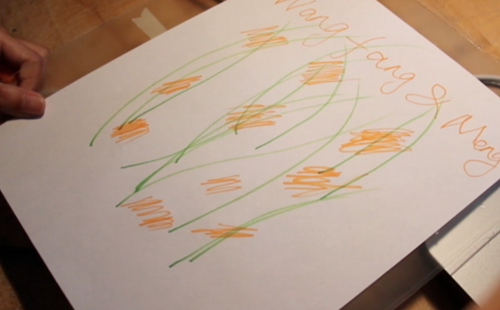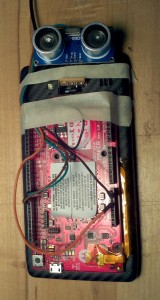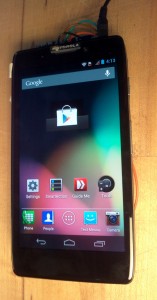Assignment 2 “Musical Painting” by Wanfang & Meng(2013)
What:
This idea came from the translation between music and painting. When somebody draws some picture, the music will change at the same time. So, it looks like you draw some music:)
How:
We use sensor to test the light, get the analog input , then transform it to sound. I think the musical painting is a translation from visible to invisible, from seeing to listening.
Why:
It is fun to break the rule between different sense. To on the question, the differences between noise, sound and music, personally thinking, that the sound is normal listening for people. The noise may be disturb people. The music is a sound beyond people’s expect. So based on the environment, people’s idea will also change, we will create more suitable music .
Assignment 2 “Musical Painting” by Wanfang & Meng(2013)
 Our idea begins from traditional Chinese Painting, painting lines express a feeling of strength and rhythm concisely. Our work tries to transfer the beauty of painting to music. However, I found that making a harmonious”sound” from people’s easy input from 9 photosensors is not as easy as I thought. I tried some “chord”,like C mA D and so on. It helps a little bit…The final result is in the vedio in Vimeo.
Our idea begins from traditional Chinese Painting, painting lines express a feeling of strength and rhythm concisely. Our work tries to transfer the beauty of painting to music. However, I found that making a harmonious”sound” from people’s easy input from 9 photosensors is not as easy as I thought. I tried some “chord”,like C mA D and so on. It helps a little bit…The final result is in the vedio in Vimeo.
I know there are pretty work to improve the “algorithm”. Although, not sound really like music, I think the value of the work is that we try to break the line between sound and light, and see what happens.
In order to find a improvement way, I observed several other interactive musical instruments works, I think maybe using some basic rhythm pieces play repeatedly and only changing the chords as interactive elements is a way of improvement of this work.
The technology we used are photo sensors and arduino and Max.
assignment1 1 from Wanfang Diao on Vimeo.
Assignment 2: “DialToneMadness” by Mauricio Contreras (2013)
DialToneMadness is an instrument that generates different audio tones, which frequency and period of repetition can be altered by proximity. It is based both in the Android and Arduino development platforms. It uses an ultrasonic based proximity sensor to measure distance to the “triggering” object, whatever that may be. The sensor is triggered and read from within Arduino and is then sent to the smartphone running Android. The latter reads this information and produces a tone based on it. Due to the aesthetic of the piece, with a high end smartphone, “retro” DTMF tones were used. This gives the audio output of the piece an interesting turn, since these sounds contain multiple tones and are not just sorted in a higher/lower pitch fashion. The smartphone responds with a single tone per message sent by the Arduino, hence the period of the repetitions is controlled by the latter, and is a linear function of the distance.


Max Extensions: Part 1
In order to add extra functionality to max, you can download and install “3rd party externals”. These are binaries that you download, unzip and place within your MAX SEARCH PATH (i.e. in Max, go to Options > File Preferences… and add the folder where you’ll put your 3rd party extensions; I recommend a folder called “_for-Max” in your “Documents” folder).
Some helpful examples:
- Physical Computing: Maxuino
- how to connect motors/lights/solenoids/leds to Max with Maxuino
- Machine Vision: OpenCV for Max (cv.jit)
- Audio Analsyis for Max: Zsa Objects (Emmanuel Jourdain) and analyzer~ (Trista Jehan)
sound sensing and arduino
- Sparkfun: Option 1 and Option 2; use with arduino FFT library for best results or detection code like this
- Phidget
- ZX-sound
- interesting board for this purpose
Sensors and Biosensing
Heart-rate Sensors and Stethoscopes:
- Commercial Hand Grip Heart Rate Monitor from Vernier
- Schematics for a Finger Plethysmograph
- Optical Heart Rate Senser
- Modern Device Puls – Heartbeat Sensor
Toys/Game Controllers:
- Neurosky (Does not work functionally with MAX: dysfunctional for Mindset and nonexistent for Mindwave)
- Emotiv (Works with Max | but maybe not Mac?)
Finger Print Scanner:
Eye/Retina Scanners:
Sensor vendors
External References